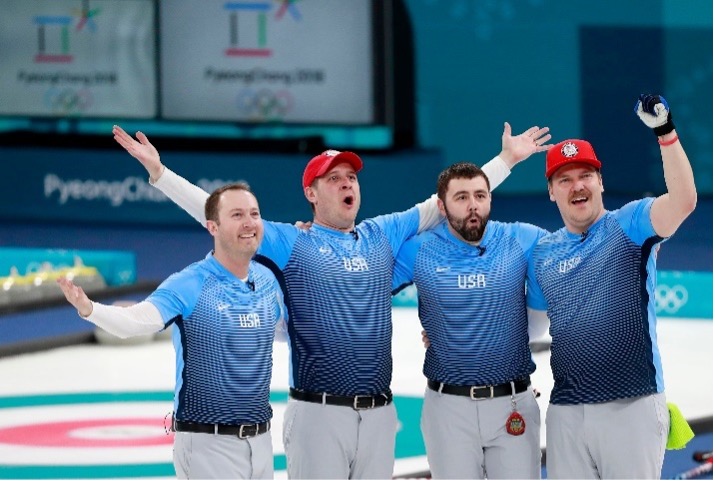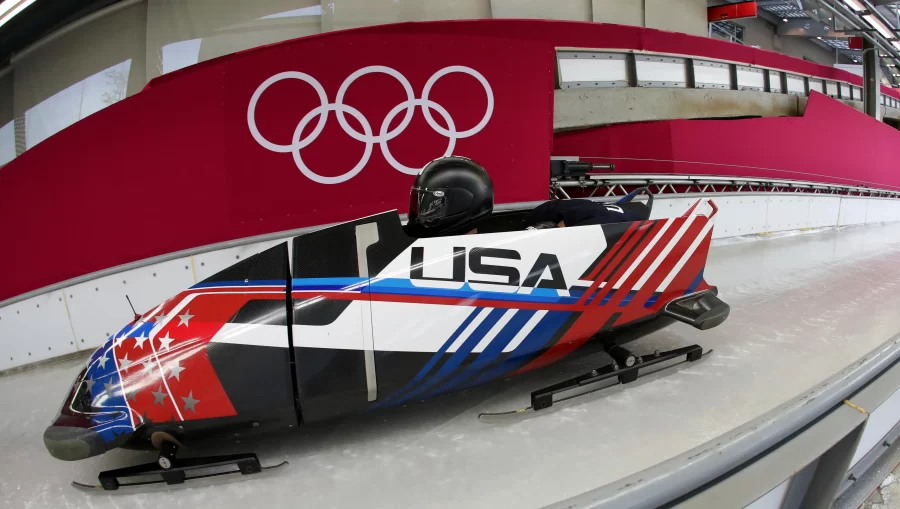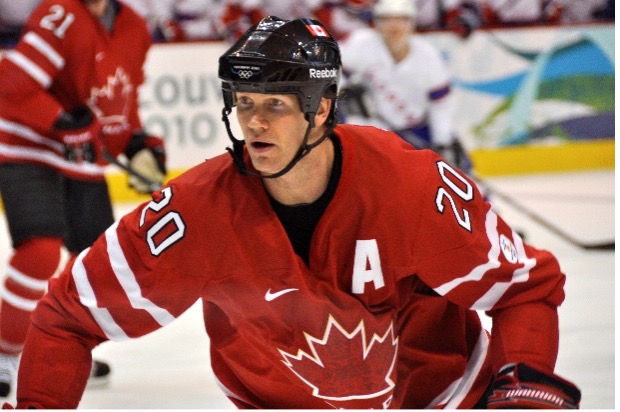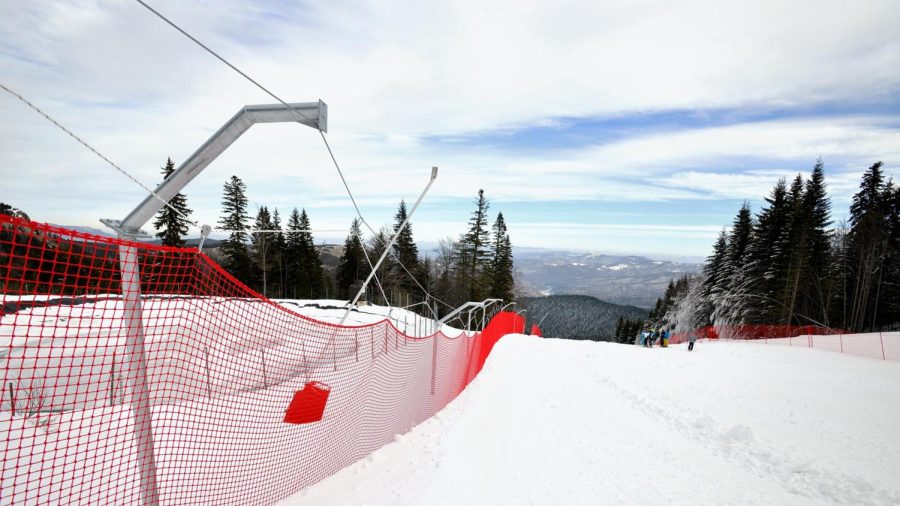Ranking the Winter Olympic Sports Based on How Likely They are To Kill a NARP
Winter Olympic Sports can be incredibly difficult, especially for those without natural athletic abilities, like NARPs.
Every four years, hundreds of thousands of people turn their eyes to the Winter Olympics to cheer for their country’s respective athletes and watch them go for the gold. As Daniel Tosh once said, “The only reason we have the Winter Olympics is so that white people can still feel relevant in sports.”
In classic white-people fashion, this, of course, means that we need to make athletic events wildly more dangerous than they’d ever need to be. We’ve already perfected this art form when it comes to the Summer Olympics, with the recent inclusion of sport rock climbing, surfing, mountain biking and BMX freestyle.
What happened to the days when we were satisfied with someone running really fast or throwing a rock really far? As always, we just had to add the possibility of falling to your death from a 50-foot rock wall to keep things interesting.
When it comes to danger, the Winter Olympics do not disappoint. Some of the events are made needlessly more extreme seemingly for the fun of it. I can only imagine the creation of the biathlon involved a conversation like this:
“Hey Sven, I was thinking. Making people cross country ski 20 kilometers through the wilderness in freezing temperatures is pretty lame. How can we spice this up?”
“You’re totally right, Olaf. How about we make people shoot rifles at targets the size of a Post-it note during the middle of it?”
“You’re a genius, Sven.”
The Winter Olympics are the perfect opportunity for a NARP (non-athletic regular person) to get in on the action. For one thing, there’s less competition. Only about a third of the Earth’s surface ever sees snowfall, and half of the states in the U.S. don’t get enough snow to produce competitive athletes.
If you’ve ever had dreams of winning gold for your country but don’t want to spend the rest of your life eating through a tube, this list is the one for you. It begins with sports that are about as dangerous as walking to the refrigerator to get a beer while finishing with sports for adrenaline junkies who have the money to afford a lift ticket and reconstructive knee surgeries.
Buckle those ski boots and throw on those long johns, NARPS, your athletic career may not be over yet.
#10: Curling: Risk of Significant Injury/Death: 0.1/10
Starting off the list, we have curling, aka shuffleboard on ice. For people who don’t know what curling is, it’s a competition where teams take turns sliding stones at a target in order to get the most points possible.
The danger factor here is basically nil. It’s about as dangerous as taking a stroll to get your mail after it’s snowed the night before. Players send the stone down the ice while their teammate chases after it with a broom, sweeping the ice in order to increase the speed of the stone and get it closer to the target.
The player who chases the stone doesn’t even run after it, opting for a hobbled shuffle like someone with a bad knee trying to make it to the toilet before they shit their pants. You could not have an athletic bone in your body and still be a half-decent curling player inside of a month. Think I’m kidding? This is a picture of the U.S. men’s curling team from the 2018 Winter Olympics that won the gold medal:

I’ll be brutally honest. When I think “Olympic athlete,” these people are not the first ones that come to mind. They look like 20-handicap golfers that blow out their hamstrings playing parking lot football at a Cleveland Browns tailgate. Your chances of getting injured while playing curling are probably limited to getting in a drunk driving accident after crushing beers with your teammates before, during and after a competition.
#9: Speed Skating: Risk of Significant Injury/Death: 4/10
Next, we have speed skating. Notice that the danger factor has increased 40x between the least dangerous sport and the second least dangerous sport. I guess the International Olympic Committee decided that having one non-deadly sport was enough.
Speed skating is relatively straightforward. Competitors skate between 500 meters and 10,000 meters in a circle, and the fastest time wins. While the sport is physically demanding and athletes certainly need to be in elite condition in order to compete, the event itself is relatively tame. Players are not allowed to make any contact with their opponents during the race.
So why the danger rating? Speed skaters can fly around the ice at speeds up to 30 mph and the blades on their skates are incredibly sharp. A NARP is one slip away from the entire ice rink looking like a scene out of “The Shining.” While many other sports injuries are able to be rehabbed, there isn’t much you can do if a skate’s blade slices you open like a tomato.
The borders to a speed skating track are well-padded, however, so as long as you don’t get decapitated by a rogue skate, you should be okay.
#8: Cross Country Skiing: Risk of Significant Injury/Death: 5/10
Is cross country skiing particularly dangerous? Not really. It takes place at relatively low speeds and the terrain isn’t terribly challenging. What makes the event so dangerous is the location of cross country skiing events. In order to find 20 kilometers of open snowy terrain, you have to be in pretty remote areas of the globe. This means that any injury sustained during the competition instantly becomes more life-threatening.
Cross country skiing also carries the risk of running into wildlife. Imagine you’re in the middle of a competition and a grizzly bear isn’t too thrilled about the race going through his habitat and fancies himself a latex-covered human snack. Elite cross country skiers can only go about 20 to 25 mph, while grizzlies can run 35 mph. Think your flimsy little poles can stop a 1,700-pound bear? You’re toast.
Additionally, NARPs are naturally suited to climate-controlled environments. Spending prolonged periods of time in the brave wilderness is sure to give NARPs a panic attack. Pack up the skis and find a sport that doesn’t involve you becoming bear bait.
#7: Biathlon: Risk of Serious Injury/Death: 5.5/10
Remember what I said about white people making sports unnecessarily more dangerous? Case and point right here. What reason was there to include a shooting aspect to an already difficult athletic event? What’s next? Running a marathon and defusing a bomb at the halfway mark? Ridiculous.
The biathlon is a wet dream for Americans who live in snowy areas. I honestly don’t know why it’s not more popular in rural, rednecky, northern regions of this country. If the game got more exposure in these areas, I don’t think we’d lose for the next 100 years.
As far as danger goes, this sport carries all of the risks of cross country skiing with the added danger of operating a firearm during the competition. While the chances of a NARP shooting themselves during a biathlon are slim, they are never zero. NARPs are not known for their tactical use of firearms.
Additionally, according to the rules, for every miss with the rifle, a competitor must ski a 150-meter penalty lap. For NARPs, this means you’ll probably be skiing penalty laps until you have a heart attack and die from the aforementioned lack of medical care. The risk of death would be higher, but the rifle can be used to fend off any of the animals that might attack you. My advice: stick to Call of Duty.
#6: Figure Skating: Risk of Serious Injury/Death: 6/10
As a NARP who is about as flexible as a piece of rebar, I think figure skating might be one of the most dangerous sports. This sport is not a matter of “if” you’re going to tear your groin attempting one of these poses, but a matter of “when.”
NARPs are not known for their flexibility and in a sport that heavily relies on it, the risk factor is dramatically increased. One minute you’re attempting a triple axel, the next your hamstring cramps up because, let’s face it, you haven’t been flexible since you hit puberty, and you fall and crack your head open on the ice.
Figure skating is one of the few sports on ice that do not involve a helmet. I understand that helmets probably clash with the outfits, but for NARPs, our brains are our only asset. We can’t endure years of CTE and carry on with our careers. One nasty fall and you throw up every time you look at the fluorescent lights at the office.
Finally, and most important, none of the outfits figure skaters wear are flattering to NARPs. No one wants to watch me crawl off the ice with a broken ankle while my gut hangs out of my leotard. If baggy tracksuits were acceptable attire for figure skating it might be more suitable for us. Even then, you run the risk of your head splitting open like a watermelon and looking like a bag of milk while doing it. Pass.
#5: Bobsled/Luge/Skeleton: Risk of Serious Injury/Death: 7/10

Remember when you went sledding as a kid and thought to yourself, “This is fun, but I wish I was going 90 mph with no protection other than a helmet?” Me neither. These three sports are just more examples of tame activities turned extreme for no reason.
Competitors throw themselves on a sled and fly down a track made entirely of ice at speeds that would get you a hefty ticket and probably a court date. Was sledding just too boring? Must the threat of death be present at every Olympic event?
If you think I’m being dramatic, a Georgian Olympian tragically died during a luge training run in 2010. That’s right, just 11 years ago. This wasn’t in the 1980s when protective equipment was probably made out of the cheap plastic they make Solo Cups out of. This was cutting-edge safety gear and it was about as useful as a screen door on a submarine. Nodar Kumaritashvili (RIP) was one of the world’s best. Not an amateur, not a semi-pro, an Olympian. If an Olympian can die during this sport, NARPs don’t stand a chance. Stick to sledding — if you crash, you can just go inside and get hot chocolate.
#4: Ski Jumping: Risk of Serious Injury/Death: 7.9/10
I won’t lie. Ski jumping looks like a surefire way to play one vs. one with Kobe Bryant while John Lennon serenades you in the background. People who do this sport are truly fearless and I’ll admit I’m a little scared of them.
While this sport is insanely dangerous, competitors travel 300 feet in the air at 60 mph, they never get more than 10 to 15 feet off the ground. Something in my brain tells me I could probably survive that fall. In ski jumping, people crash all the time and most of them are able to walk away from it. It’s incredibly difficult, but at the same time, all you have to do is land on your two feet. Easier said than done? Absolutely.
Maybe the only good part about this sport is that if you’re going to crash, you probably have a good amount of time to reflect on your life before you hit the ground. I don’t really need to make a strong case as to why NARPs shouldn’t try this sport because there is no way in hell a career NARP randomly decides to start ski jumping. If you were thinking about it, though, please don’t.
#3: Freestyle Ski/Snowboard: Risk of Serious injury/Death: 8.5/10
Freestyle snowboarding/skiing are the height of reckless endangerment. Competitors can launch themselves up to 65 feet above the landing site all while performing death-defying tricks mid-air. Landing on skis is hard enough. If I tried to land after attempting three spins with a backflip mixed in there, my body would simply combust on impact.
I don’t care how soft the snow is — if a NARP wants to get into this sport, just know you’ll break something. Freestyle snowboarding/skiing are like ski jumping except they decided to up the danger factor by 100.
Getting down the half-pipe without even doing any tricks would be virtually impossible. Add a backflip or two to the equation and you have a recipe for disaster. This is so far out of a NARP’s league it’s ridiculous. The best you can hope for is to get approximately four inches off the ground and call it a day before you need a keyboard to speak for the rest of your life. If you’re thinking about attempting to get into this sport, do yourself a favor and schedule the physical therapy sessions ahead of time — thank me later.
#2: Ice Hockey: Risk of Serious Injury/Death: 9/10
Ice hockey is one of the most difficult sports you can play. Skating in and of itself is incredibly difficult. Hoping to score a goal is a lost cause. Add in the possibility of taking a 100 mph slapshot to the face — no protection, by the way — and it becomes extremely unappealing.
Hockey players suffer an extraordinary number of minor injuries. They tear ligaments, break bones and get concussions like I get coffee at Dunkin’. And those are just the minor injuries — we haven’t even begun to talk about the number of hockey players who experience long-term injuries from playing the game.
What makes hockey so dangerous for NARPs, however, is that it’s actively played against an opponent. Many Winter Olympic sports are individual competitions. In hockey, you’re faced with the fact that some of the toughest people on the planet are constantly trying to turn your body into a chalk outline on the ice.

See that guy? That’s Chris Pronger. He’s 6’8” on skates, 230 pounds. Notice the lack of a face shield. The blank expression on his face. He will kill you. He doesn’t care about getting hurt so long as he can hurt you. He would happily put you in a wheelchair for the rest of your life if it helped his team win a game.
I would rather walk 100 miles on broken glass than take a hit from Chris Pronger. If a NARP does want to try ice hockey, be prepared to lose a few teeth, your short term memory and probably your dignity.
#1: Alpine Skiing: Risk of Serious Injury/Death: 9.9/10
At the top of our list is alpine skiing. This sport has it all. And by has it all, I mean it has all of the reasons why it would kill a NARP if they tried it. It has the speed of ski jumping, the razor-sharp edges of speed skating, the icy surfaces of luge/skeleton/bobsled, the air of freestyle skiing and the glory of curling.
Athletes fly down a long, icy course that features twists, turns, jumps and a risk of bodily harm not found in any other Olympic event. Skiers hit speeds of 80 mph while the course drops them 1,100 meters in a matter of seconds. It’s a few feet away from straight-up skydiving.
If that wasn’t enough to scare off a NARP, there’s the matter of protection. The only bodily protection you have is a helmet. I don’t care how effective they are, if the only thing separating my brain and the ground at 80 mph is an inch of plastic, I’m not doing it.
If you drove your car at 80 mph with no seatbelt on, people would think you were insane. If you did it without airbags, they’d think you were completely insane. If you did it with nothing between you and the ground but a thin-skin suit, people would think you were trying to kill yourself. Then you have the course’s protection. Most alpine skiing courses are near trees. The only thing preventing you from flying into the trees at full speed and killing you instantly?

This dinky fence. Alpine skiing has been in the Olympics since 1936, and this is the best they could come up with? How has no one addressed this in 75+ years this sport has been around? Am I meant to believe that a few pieces of string are supposed to prevent my body from exploding into a million pieces? I’ve seen better fencing at my county fair, and that’s just to prevent drunk people from sneaking onto the Tilt-A-Whirl.
Not only do I think NARPs should steer clear of this event, I think it should be put on hold until we can come up with something better than a fishing net to save skiers’ lives. Perhaps the worst aspect of alpine skiing is that all the risk is for virtually nothing. Olympic glory is cool and all, but if I’m risking a trip to the morgue every time I put on my skis, I’d better be earning some serious dough.
At least hockey players make enough to retire by the time they’re 40. The best alpine skiers only make around $30,000 a year. That’s about $5,000 more than the average janitor. Even if you’re not in it for the money, the fame is marginal at best. Think of the most famous athletes ever. Any alpine skiers on there? Didn’t think so. Can you even name five alpine skiers? Me neither. Alpine skiing is all risk, no reward. If a NARP does want to ski, I recommend sticking to the groomed runs, playing it safe and chilling in the hot tub at the resort.
This article is not meant to disparage any of the Winter Olympic events. I think I speak for all NARPs when I say we appreciate the risks these athletes take to represent our country and provide us a month’s worth of entertainment after the NFL season has ended and March Madness has yet to begin. My hat’s off to you, Olympians, but it’s a baseball hat, because I’ll be somewhere warm, watching you on my TV.
Your donation will support the student journalists of Bates College and help us cover our annual website hosting costs.








Easton • Jan 5, 2025 at 6:32 AM
Alpine skiers don’t just wear a thin ski suit, underneath those race bodysuits are padding and an inflatable vest. If crashes occur, they have a lot of protections. That said, severe injuries are still extremely common in alpine skiing!
Amaiya • Jul 19, 2024 at 9:54 PM
I believe equestrian sports should be in the rankings, considering they ride 600kg animals who have their own mind body and soul which also jump 5 ft objects and gallop and 60km/ph